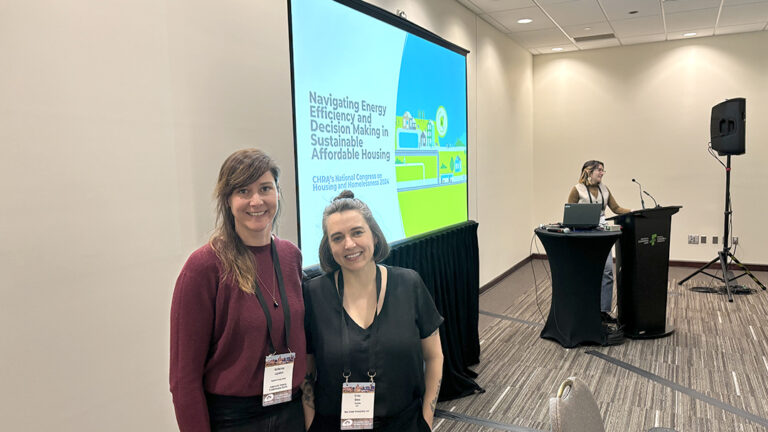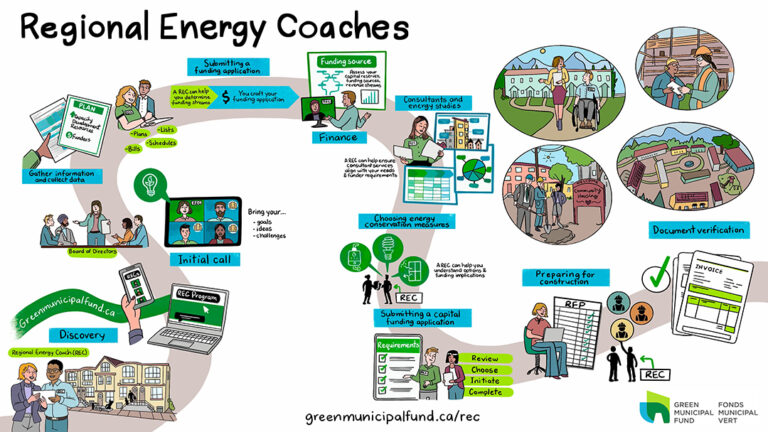The construction and operation of buildings is responsible for a large part of global carbon emissions. Ever wondered how you can do your part to make housing greener? Here are a few ideas—that could also benefit from a grant from the Centre—to get you started.
While world scientists have been warning of a climate emergency for years, many are still divided on what it takes to curb the negative trend. The consensus is clear, however, that housing plays a crucial role in the global energy consumption.
Indeed, the energy required to construct and operate buildings is responsible for nearly 40% of global carbon emissions.
“The largest part of energy consumption is housing-related, it comes from people heating their homes,” says Stéphan Corriveau, executive director at the Community Housing Transformation Centre.
“If you can generate energy more efficiently, through windmills, for example, part of the equation remains: how is your housing stock built, maintained, and managed? Are you as efficient as you need to be?”
There is opportunity for change: green construction and sustainable processes have slowly but surely made their way into the mainstream, meanwhile there are many other areas where it is possible, and therefore necessary, to act.
“Small interventions are the beginning of organizational transformation,” adds Amy Bolt, the Centre’s program manager in charge of environment.
Environmental projects come in many shapes and forms, and don’t always include soil, seedlings, or solar panels.
“Sure, the goal is to help housing providers reduce their environmental footprint,” shares Bolt. “But it’s just as important to help tenants do the same, on a micro level. Not every act has to be revolutionary: we can start by promoting the use of existing tools and encouraging the adoption of best practices. That can be quite transformative.”
“Even by simply creating space for a conversation, you might find that there are small, cost-effective interventions that have financial, social, and environmental benefits.”
This can be done by educating tenants about proper waste disposal, setting up a mechanism for tenants to report things like leaky faucets, or establishing a tenant-led eco-responsible committee.
“If you start with small steps, you will notice that larger interventions will become more attainable, no matter your organization’s size or capacity, or the location or condition of your housing,” says Bolt.
Here are some initiatives that could benefit from funding from the Centre.
Community-Based Tenant Initiative Fund
The Community-Based Tenant Initiative Fund raises awareness and supports new and improved tenant engagement practices.
1 – Tenant-led training and education
Tenants may lead training programs about ways in which they can save energy or implement small environmentally friendly initiatives within their housing. This could also involve the creation and maintenance of a reference guide for tenants, by tenants, on how to better operate energy-consuming equipment, like thermostats, and recognize when there is an issue that should be reported to management.
2 – Create and operate a tenant-run eco-responsibility group
Tenants can set up a committee or taskforce to be encouraged and able to participate in conversations around potential interventions, and to work with management to ensure that future housing decisions incorporate environmental sustainability. Some other responsibilities of the committee/taskforce could involve engaging with their local community regarding these issues or sourcing other funding opportunities such as the Co-operative Housing Federation of Canada’s Green Microgrants program.
3 – Tenant engagement in the planning and design process of a sustainable housing (re) development project
A housing provider may undergo a consultation process prior to undergoing deep retrofits or new constructions to gauge tenant concerns, needs, and wants. Tenants could be further involved in the elaboration of the design itself through a participatory-design process or environmental design workshops.
4 – Sustainable affordable housing advocacy
Community housing providers, sector service providers, and tenants could gather and organize community support to ultimately advocate for policies and incentives associated with energy retrofits, proper waste disposal, reduced energy consumption, etc. As long as they are housing related, some project ideas could include producing a podcast or forming a youth tenant group expressly responsible with environmental advocacy.
5 – Tenant-led energy assessments
Tenants may engage with a participatory-action research project that would involve developing and piloting a tenant-led energy assessment. This type of project would ensure tenants are equipped with the materials to evaluate energy conservation measures within their housing and work together to identify key issues and propose solutions—such as educating other tenants about how to better operate energy-consuming equipment, establishing an environmental taskforce, or undergoing a deep energy retrofit through the FCMs Sustainable Affordable Housing fund.
Sector Transformation Fund
The Sectoral Impact stream supports either sectoral service providers, community housing providers or those who are responding to a large, identified gap within the community housing sector. The Local Projects Stream is meant to support local community housing providers, individually or as a small group. to bring more or better services to their communities and increase organizational capacity.
1 – Kickstart a shared service program
Local community housing providers can partner to share services—like jointly hiring a floating energy conservation project coordinator who would be responsible for evaluating and implementing low-cost/no-cost energy-saving measures and searching for funding opportunities. The Centre’s grant would go towards initiating partnerships and start-up operations. The dollars saved through reduced operating costs could go towards funding the project coordinator after the initial start-up phase.
2 – Start a buying group
Provincial associations, local housing corporations, and larger community housing providers can set up a structure to offer a buying service to smaller providers. These organizations can develop procurement plans and engage with smaller community housing providers within their local contexts to purchase equipment in bulk—such as low-flow toilets—making environmentally friendly retrofits more financially feasible for smaller groups.
3 – Establish an incentive program for tenants to reduce energy consumption
Community housing providers can evaluate the feasibility of implementing an incentive program that would encourage tenants to reduce their energy consumption. Utility bill savings could directly impact tenant’s rent structures or be set aside as a “sustainability fund” to implement projects at the tenant’s discretion—such as building a community garden, planting trees, or adding bicycle storage.
4 – Establish non-profit housing organizations or sector service providers
Funding is available to establish, incorporate, and initiate the operations of a non-profit housing provider, co-operative housing provider, or community-housing sector service provider.
Particular attention will be given to groups who have a mission to reduce the environmental footprint of the sector, and answer to gaps in service for Indigenous communities. For example, Indigenous communities may wish to establish non-profit housing organizations so they can access additional funding to plan, build, and operate sustainable affordable housing.
***
“The initial step into the environmental space is always the hardest, particularly for smaller organizations without the resources, confidence, or capacity to engage with these often-overwhelming projects,” says the Centre’s program manager in charge of environment, Amy Bolt.
She hopes these ideas may provide confidence to non-profits and inspire action.
“Let’s come together –residents, management, site staff, boards–to share our experiences and brainstorm creative and realistic eco-responsible opportunities, no matter their size!”
Got any green housing ideas you want to bring to life? Contact us at info@centre.support or 1-833-360-3967.



